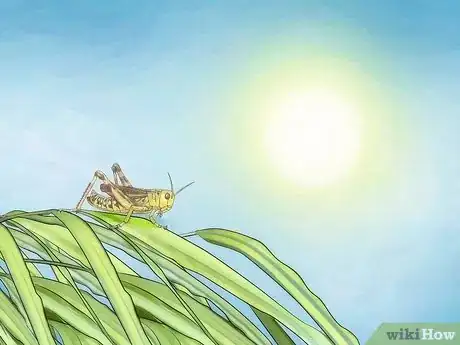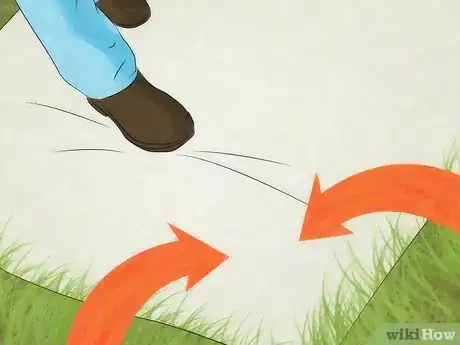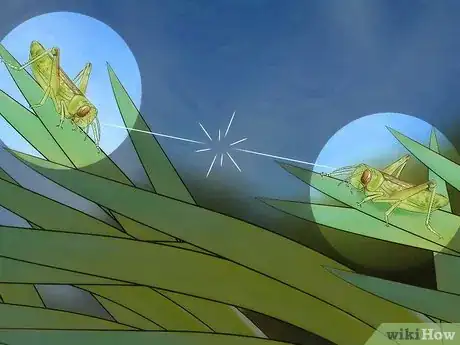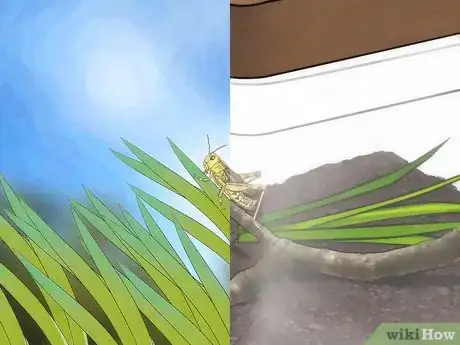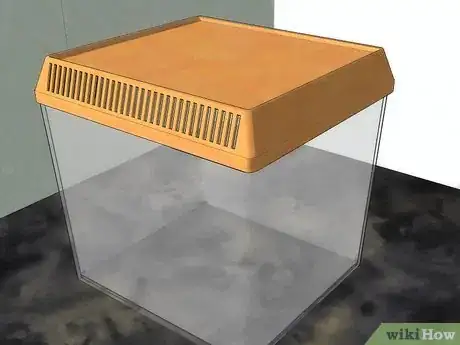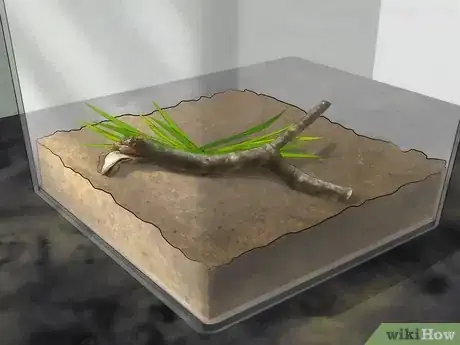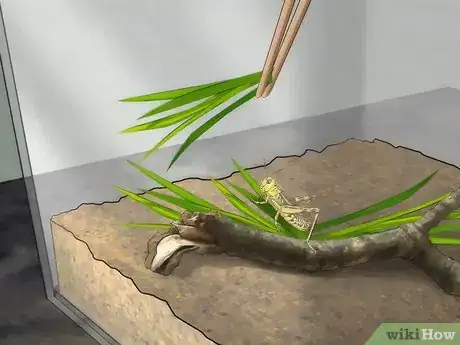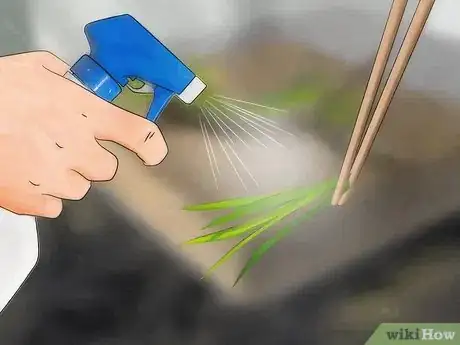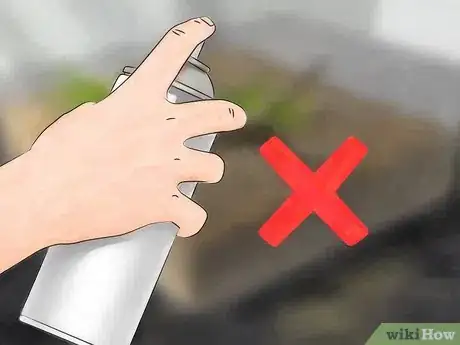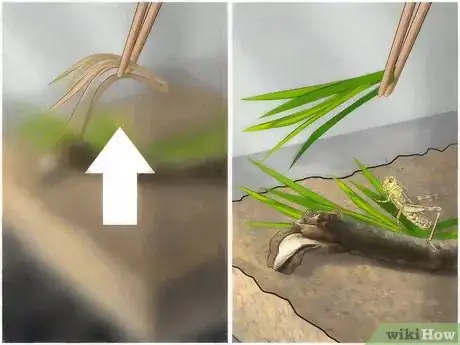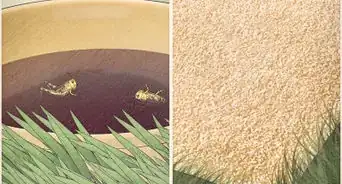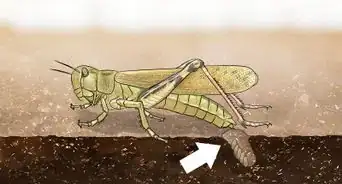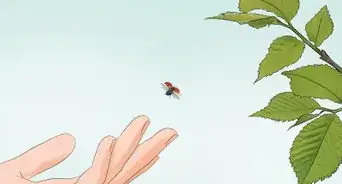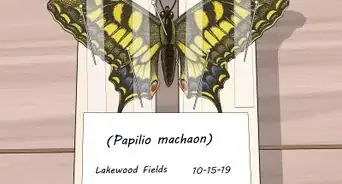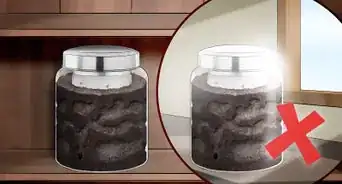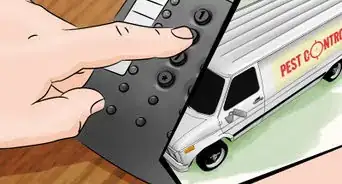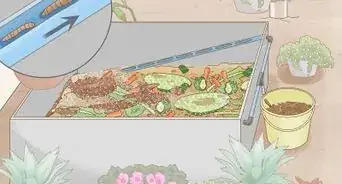This article was co-authored by Samuel Ramsey, PhD. Dr. Samuel Ramsey is an Entomologist and a researcher with the United States Department of Agriculture. Dr. Ramsey has extensive knowledge of symbiosis and specializes in insect disease spread, parasite behavior, mutualism development, biological control, invasive species ecology, pollinator health, and insect pest control. He holds a Bachelor’s degree in Entomology from Cornell University and a Ph.D. in Entomology from the University of Maryland. Dr. Ramsey’s research on bees has enabled researchers to develop targeted control techniques to restore honey bee populations worldwide. He also hosts a YouTube series called “Dr. Buggs.”
There are 7 references cited in this article, which can be found at the bottom of the page.
wikiHow marks an article as reader-approved once it receives enough positive feedback. This article received 27 testimonials and 91% of readers who voted found it helpful, earning it our reader-approved status.
This article has been viewed 274,370 times.
For those interested in keeping insects as pets, grasshoppers offer a good choice as they are inexpensive (even free), don’t require any type of special food, and don’t need much in the way of space or other supplies.[1] However, in order to keep your grasshopper healthy, you’ll need to follow a few basic steps to make sure his home is warm and dry, and that his food is safe for consumption.
Steps
Finding and Catching a Grasshopper
-
1Choose the right time to find a grasshopper. Grasshoppers are found on every continent in the world except Antarctica.[2] If you live in a very warm part of the world where it does not get cold even in the winter, you may be able to find grasshoppers at any time during the year. However, if you live in a part of the world with warm summers and very cold winters you will probably only be able to find grasshoppers during the warmer months of the year when the temperature no longer reaches freezing at any point during the day or night.
- Grasshoppers cannot move easily if they are not warm. Thus, in the morning just after the sun has come up might be the easiest time to catch them as they cannot jump away quickly. However, they may be difficult to spot since they blend in well with their environment. If you cannot find one in the early morning, try coming back in the middle of the day when they are more active and easier to notice.
-
2Look for grasshoppers in the right area. Depending on where you live, grasshoppers may be very easy to find. Look for grasshoppers in grassy fields, empty lots, or along riverbanks in the grass. Grasshoppers like to eat leaves and grass, so anywhere you can find these you can probably also find grasshoppers.[3]
- If you have a garden outside your home, you can probably find a few grasshoppers there too.
Advertisement -
3Set a trap. To catch your grasshopper, you can use a fine mesh net, a t-shirt, or a flannel blanket to catch your grasshopper. Lay the net or blanket out on the ground and then walk towards the blanket, which will cause any grasshoppers in your path to jump forwards on to the blanket. If it is fuzzy enough, it will be difficult for the grasshopper to jump away quickly.[4]
- Once you have the grasshopper on the blanket, quickly place a glass jar over the top of the grasshopper. Slide a thin piece of cardboard underneath the lid of the jar to keep him in while you flip the jar right side up, and place the lid on.
- You may also be able to simply catch the grasshopper while he is sitting on a blade of grass. Approach the grasshopper slowly and carefully, getting as close as you can. When you are within arms reach, try to quickly place the jar over the top of him before he jumps away. This may take a few tries, but eventually you’ll catch one.
-
4Use a glass jar to transport your grasshopper. You can use the jar you used to catch your grasshopper to take him home. A glass jar with a screw-top lid works well for this. Just make sure to poke a few holes in the lid before you go catch your grasshopper so that he can breathe inside the jar.
- If you are young, ask an adult to help you poke the holes in the lid using a sharp knife or some scissors.
-
5Be aware of keeping multiple grasshoppers. If you want to have more than one grasshopper it is important to be aware of the consequences of doing so. Keeping two or more grasshoppers may result in fights, especially if you don’t give them more than enough food. If you keep males and females together, they will breed.[5]
- If you want to breed your grasshoppers, then just put a male and female together in the terrarium. The female will lay her eggs in the filler of the terrarium, and these eggs will hatch into many young nymphs, which look just the same as adults, but much smaller.
- If you do not want to deal with baby grasshoppers, do not keep a male and female together. If you notice that a female grasshopper has laid eggs and do not want any babies, you can dig up all the eggs and put them in the freezer, which will kill the eggs.
- Do not release baby grasshoppers into the wild as it may disrupt the natural patterns of the ecosystem.
-
6Understand what you are committing to. In the wild, grasshoppers typically only live for a short time. If they are not killed by cold weather, they are usually killed by natural predators. However, in theory, a grasshopper can live for a few years in a warm and safe environment. If you are planning to keep a grasshopper as a pet, then understand that you are potentially committing yourself to caring for your grasshopper for quite awhile.[6]
- This will require you to maintain their terrarium, feed them every day, and ensure that they are kept in an environment that is warm enough to keep them healthy.
- If you don’t think you are ready for this commitment, look for an insect that has a naturally shorter lifespan.
Housing Your Grasshopper
-
1Get a glass or plastic terrarium. You will likely want to watch your grasshopper in action, so a clear glass terrarium is a great place to keep your grasshopper. Make sure that it is big enough for your grasshopper to have some room to move around, and that the terrarium has a plastic or metal mesh lid to cover the top.[7]
- Grasshoppers can chew through fabrics, so net cages or cages with fabric mesh lids will not be able to contain your grasshopper for long.
- Grasshoppers are talented jumpers so make sure that the grasshopper has a bit of space to jump around.
- You can find terrariums at most pet stores.
- Depending on the size of your grasshopper, a 5 to 10 gallon terrarium should be sufficient.
-
2Consider the size of your grasshopper. There are believed to be over 10,000 species of grasshoppers on the planet with sizes of adult grasshoppers varying between 0.39 inches (1 cm) and 2.76 inches (7 cm). To get an idea of how big your grasshopper might grow, take a look at the size of the grasshoppers in the area where you caught yours. Your grasshopper is likely the same species as these, so should grow to a similar size.[8]
- Female grasshoppers tend to grow larger than male grasshoppers. If you want to identify whether your grasshopper is male or female then look at their abdomen. Female grasshoppers will have four sharp points at the end of their abdomen that they use to deposit their eggs into the ground. Males will have smooth, rounded abdomens.[9]
- Make sure that your terrarium is suitable for the size of your grasshopper. Small grasshoppers will not need much space to be content, but a larger grasshopper will need more space to jump around.[10]
-
3Fill the bottom of the terrarium. You can fill the bottom with dry sand, dry oatmeal flakes, or even dry coconut fibers. This will make the terrarium more comfortable for your grasshopper. Make sure to fill it with just an inch or two so that your grasshopper still has lots of space.[11]
- Place some twigs and sticks into the terrarium so that your grasshopper has a place to sit, and can jump from twig to twig.
-
4Ensure that some light gets into the terrarium. Grasshoppers need a dry and warm environment in order to thrive. During the day, your grasshopper’s home should be between 77 °F (25 °C) (25 Celsius) and 95 degrees Fahrenheit (35 Celsius). You can easily do this by having a lightbulb that shines into the terrarium during the day.[12]
- You can also purchase a heat mat or a species light bulb at your local pet shop (call to see if they have reptile supplies before making the trip) to heat the terrarium, but a normal light bulb can also do the trick.
- While some sunlight is OK, don’t place your grasshopper’s terrarium in a place where it will receive direct sunlight as this may cause the terrarium to overheat.
- At night, it is OK for the temperature of the terrarium to drop as low as 60 °F (15.6 °C) (15 Celsius). To do this, you can just turn the light off at night, but don’t forget to turn it back on in the morning. A grasshopper that is too cold will be lethargic, and may even die.
Feeding Your Grasshopper
-
1Choose grasses for your grasshopper. Grasshoppers will eat nearly any type of grass. To give them some variety, go outside and choose some different types of grass that you come across. For example, choose some grass from the lawn, as well as some wild grass that you find in empty lots or next to river banks.[13]
- Don’t worry about giving them something that is poisonous. If the grass you put in their home is poisonous they simply won’t eat it. Then you know for next time.
- Grasshoppers will also eat leaves, too.
- Make sure to give your grasshopper plenty of fresh grass and leaves to eat every single day. Grasshoppers can eat up to 16 times their own body weight, so they may eat more than you think. Additionally, if you have more than one grasshopper in your terrarium, they make fight and kill each other if there is not enough to eat so better to have too much than too little.
-
2Spray the leaves with water before feeding. Grasshoppers do need moisture to survive, but in most cases they will get all the water they need from the grass that you feed to them. However, if you live in a very dry area, you can wet the grass with some water either by using a spray bottle to spray the leaves before placing it in the terrarium or by running the leaves quickly under the faucet to wet them.[14]
- Grasshoppers don’t do well with a lot of humidity. While a few wet blades of grass won’t do any harm, a moist terrarium may cause problems. Avoid getting the filler you have placed in the bottom wet, and be sure to regularly clean out any grass that is left uneaten.
-
3Avoid insecticides. Try to collect your grasshopper’s food from places you know are free from insecticides and other pesticides, as this may kill your grasshopper if consumed. If you get his food from your lawn, make sure that there haven’t been any insecticides sprayed on the area where you have collected the grass from.[15]
- In general, if you collect his grass from a place that is not being cultivated by humans (e.g. an abandoned lot where the grass has grown up) then you will not have to worry about insecticides.
-
4Clean out any dried out, uneaten grass. It is OK to give the grasshopper more than you think they could possibly eat, as they eat quite a lot. However, to keep their terrarium healthy and dry, you should clean out any wilted, dried out, or moldy grass/leaves as soon as you see them. Replace with fresh food at least one time each day.[16]
- Be aware that they may also eat during the night so make sure there is food available to them at all times.
Expert Q&A
Did you know you can get expert answers for this article?
Unlock expert answers by supporting wikiHow
-
QuestionWhat do grasshoppers prefer to eat?
 Samuel Ramsey, PhDDr. Samuel Ramsey is an Entomologist and a researcher with the United States Department of Agriculture. Dr. Ramsey has extensive knowledge of symbiosis and specializes in insect disease spread, parasite behavior, mutualism development, biological control, invasive species ecology, pollinator health, and insect pest control. He holds a Bachelor’s degree in Entomology from Cornell University and a Ph.D. in Entomology from the University of Maryland. Dr. Ramsey’s research on bees has enabled researchers to develop targeted control techniques to restore honey bee populations worldwide. He also hosts a YouTube series called “Dr. Buggs.”
Samuel Ramsey, PhDDr. Samuel Ramsey is an Entomologist and a researcher with the United States Department of Agriculture. Dr. Ramsey has extensive knowledge of symbiosis and specializes in insect disease spread, parasite behavior, mutualism development, biological control, invasive species ecology, pollinator health, and insect pest control. He holds a Bachelor’s degree in Entomology from Cornell University and a Ph.D. in Entomology from the University of Maryland. Dr. Ramsey’s research on bees has enabled researchers to develop targeted control techniques to restore honey bee populations worldwide. He also hosts a YouTube series called “Dr. Buggs.”
Entomologist
-
QuestionDoes the size of the enclosure matter?
 Samuel Ramsey, PhDDr. Samuel Ramsey is an Entomologist and a researcher with the United States Department of Agriculture. Dr. Ramsey has extensive knowledge of symbiosis and specializes in insect disease spread, parasite behavior, mutualism development, biological control, invasive species ecology, pollinator health, and insect pest control. He holds a Bachelor’s degree in Entomology from Cornell University and a Ph.D. in Entomology from the University of Maryland. Dr. Ramsey’s research on bees has enabled researchers to develop targeted control techniques to restore honey bee populations worldwide. He also hosts a YouTube series called “Dr. Buggs.”
Samuel Ramsey, PhDDr. Samuel Ramsey is an Entomologist and a researcher with the United States Department of Agriculture. Dr. Ramsey has extensive knowledge of symbiosis and specializes in insect disease spread, parasite behavior, mutualism development, biological control, invasive species ecology, pollinator health, and insect pest control. He holds a Bachelor’s degree in Entomology from Cornell University and a Ph.D. in Entomology from the University of Maryland. Dr. Ramsey’s research on bees has enabled researchers to develop targeted control techniques to restore honey bee populations worldwide. He also hosts a YouTube series called “Dr. Buggs.”
Entomologist
Warnings
- Don’t keep more than one or two grasshoppers at a time as it is likely that they will fight. It won’t be pleasant to come home and find that one of your grasshoppers is eating the other ones.⧼thumbs_response⧽
Things You’ll Need
- Terrarium
- Glass jar
- Small piece of cardboard
- Net, t-shirt, or fuzzy flannel blanket
- Twigs
- Sand
- Plenty of grass to feed the grasshopper
References
- ↑ http://animals.mom.me/grasshoppers-pets-4544.html
- ↑ http://www.biokids.umich.edu/critters/Acrididae/
- ↑ http://www.utahfishinginfo.com/tips/catch_bait/grasshoppers.php
- ↑ http://www.utahfishinginfo.com/tips/catch_bait/grasshoppers.php
- ↑ http://www.keepinginsects.com/cockroaches-locusts-ants/grasshoppers/
- ↑ http://www.biokids.umich.edu/critters/Acrididae/
- ↑ http://www.keepinginsects.com/cockroaches-locusts-ants/grasshoppers/
- ↑ http://www.biokids.umich.edu/critters/Acrididae/
- ↑ http://animals.mom.me/sex-determination-system-grasshoppers-9036.html
- ↑ Samuel Ramsey, PhD. Entomologist. Expert Interview. 20 January 2021.
- ↑ http://www.keepinginsects.com/cockroaches-locusts-ants/grasshoppers/
- ↑ http://www.keepinginsects.com/cockroaches-locusts-ants/grasshoppers/
- ↑ https://animalcorner.co.uk/animals/grasshopper/
- ↑ http://www.keepinginsects.com/cockroaches-locusts-ants/grasshoppers/
- ↑ http://www.keepinginsects.com/cockroaches-locusts-ants/grasshoppers/
- ↑ http://www.keepinginsects.com/cockroaches-locusts-ants/grasshoppers/
About This Article
To take care of a grasshopper, keep it in a 5-10 gallon terrarium made of glass or plastic. You can make the terrarium more comfortable for your grasshopper by filling the bottom of it with dry sand or dry oatmeal flakes and a few twigs and sticks. Place the terrarium in a bright, warm place that receives indirect sunlight and feed your grasshopper plenty of fresh grass and leaves every day to keep it healthy. For tips on keeping the terrarium clean and comfortable for your grasshopper, read on!
